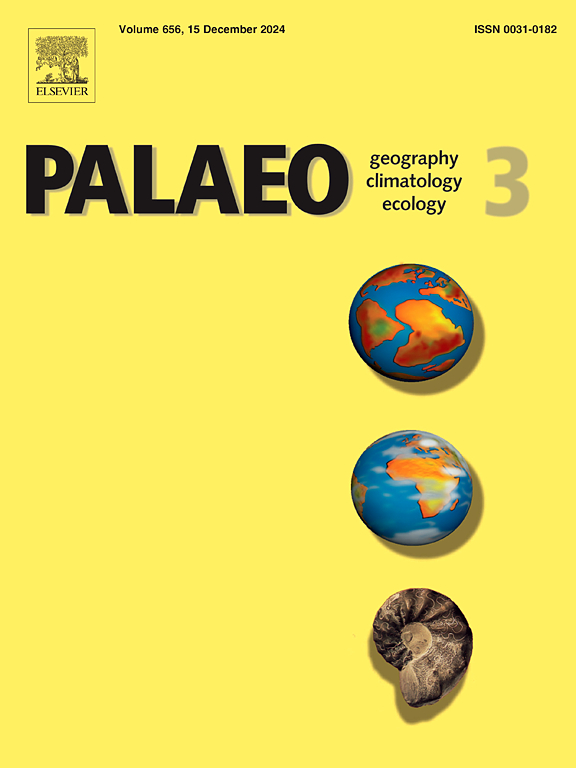Oceanic anoxia in Panthalassa during the Early Triassic Smithian–Spathian transition
IF 2.7
2区 地球科学
Q2 GEOGRAPHY, PHYSICAL
Palaeogeography, Palaeoclimatology, Palaeoecology
Pub Date : 2025-06-03
DOI:10.1016/j.palaeo.2025.113080
引用次数: 0
Abstract
The Smithian–Spathian transition during the Early Triassic was associated with significant environmental change, including global warming and oceanic anoxia. However, understanding ocean redox conditions in the pelagic Panthalassa during this period has been challenging due to a lack of well-dated sedimentary sections. Here, we provide new geochemical data for a Smithian–Spathian succession from an accretionary complex of central Japan (Inuyama, Aichi Prefecture), which was deposited in a low-latitude abyssal location. Conodont index fossils and carbon isotope stratigraphy reveal that the studied sections span the middle Smithian to lowermost Spathian (Momotaro-Jinja lower section), and the middle part of the Spathian (Momotaro-Jinja upper section). The Smithian–Spathian boundary is placed within a thick (∼40 cm), organic-rich, black claystone layer in the lower part of the section. We reconstruct water column redox conditions using pyrite framboid size ranges, Fe speciation and redox sensitive trace elements. During the middle to late Smithian, we find that the water column changed from oxic to ferruginous anoxic, with a transition to euxinic during the latest Smithian to earliest Spathian. During the middle Spathian, the water column fluctuated between oxic and euxinic conditions. We suggest that late Smithian seawater warming contributed to deoxygenation of Panthalassa whilst surface productivity and organic matter fluxes were low, leading to non-sulfidic ferruginous anoxia. Productivity then increased during the latest Smithian to earliest Spathian, thereby stimulating microbial sulphate reduction and inducing widespread ocean euxinia.
早三叠纪smith - spathian过渡时期Panthalassa的海洋缺氧
早三叠世的史密斯-斯帕提亚过渡与重大的环境变化有关,包括全球变暖和海洋缺氧。然而,由于缺乏年代准确的沉积剖面,了解这一时期Panthalassa上层海洋的氧化还原条件一直具有挑战性。本文为日本中部(爱知Inuyama, aiichi Prefecture)一个沉积于低纬度深海的增生杂岩的Smithian-Spathian序列提供了新的地球化学数据。牙形石指数化石和碳同位素地层学研究表明,研究剖面跨越史密斯统中至斯帕塔统最下端(莫莫塔罗-金贾下端)和斯帕塔统中段(莫莫塔罗-金贾上端)。Smithian-Spathian边界位于剖面下部厚(~ 40 cm)、富含有机物的黑色粘土层内。我们利用黄铁矿晶格尺寸范围、铁形态和氧化还原敏感微量元素重建水柱氧化还原条件。在史密斯纪中晚期,水柱由含氧向含铁缺氧转变,在史密斯纪晚期至斯巴达纪早期向含氧过渡。在Spathian中期,水柱在缺氧和缺氧条件之间波动。我们认为,斯密世晚期海水变暖促进了Panthalassa的脱氧,而表面生产力和有机质通量较低,导致非硫化物含铁缺氧。在史密斯纪晚期到斯帕塔纪早期,生产力增加了,从而刺激了微生物硫酸盐的减少,并引起了广泛的海洋缺氧。
本文章由计算机程序翻译,如有差异,请以英文原文为准。
求助全文
约1分钟内获得全文
求助全文
来源期刊
CiteScore
5.90
自引率
10.00%
发文量
398
审稿时长
3.8 months
期刊介绍:
Palaeogeography, Palaeoclimatology, Palaeoecology is an international medium for the publication of high quality and multidisciplinary, original studies and comprehensive reviews in the field of palaeo-environmental geology. The journal aims at bringing together data with global implications from research in the many different disciplines involved in palaeo-environmental investigations.
By cutting across the boundaries of established sciences, it provides an interdisciplinary forum where issues of general interest can be discussed.

 求助内容:
求助内容: 应助结果提醒方式:
应助结果提醒方式:


